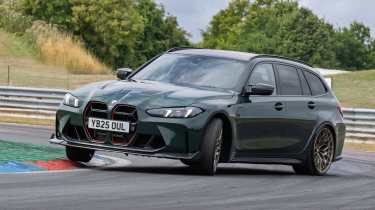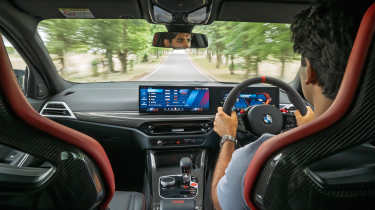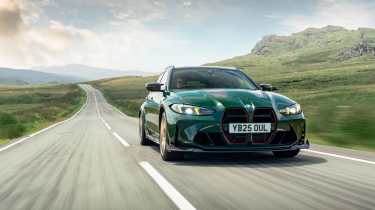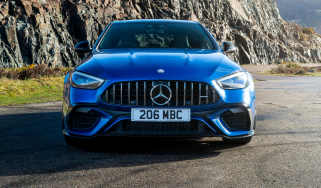BMW M3 CS Touring 2025 review – the Nürburgring’s fastest-ever estate tested
BMW gives the M3 Touring the CS treatment and creates another absolute dream of a driver’s car – and the fastest estate to lap the Nordschleife
The world probably doesn’t need an estate car with 543bhp, Cup 2 tyres and carbon bucket seats. Nor one with carbon body panels and a cooling package specified for hard track miles. But after driving the new M3 CS Touring on the road and lapping it extensively on one of the most demanding circuits in the UK, we can’t help but conclude that, in a strange way, it absolutely does. The CS Touring is a remarkable package. Staggeringly expensive at £126,275, but if you’re looking for a factory-spec wagon that can turn its hand to everyday duties and hunt down 911s on track without breaking a sweat, this is the only one.
The CS formula is familiar by now (and tends to go quite well at evo Car of the Year, the last-generation M2 and M5 taking outright victory in 2020 and 2021 respectively). More power, a little less weight and detailed chassis changes bring out more aggression than Competition models without reaching extreme CSL or GTS levels. The M3 saloon and M4 have already had the treatment, and it seems someone at BMW couldn’t resist the idea of a more focused Touring. We applaud that person.
Under the skin the Touring gets the same uprated straight-six as its CS siblings, with increased turbo boost pressure and management tweaks giving it 543bhp and 479lb ft. The engine is secured with stiffer mounts and breathes through a titanium rear silencer, sending power to all four wheels via an eight-speed auto and xDrive four-wheel drive. The stability control gets a CS-specific tune, so too the adaptive dampers, steering and standard M Compound braking system, with carbon-ceramics being a very pricey £8800 option. Weight has been trimmed by 15kg compared with the standard Touring, to what is still a chunky 1850kg. The saving comes from a carbon bonnet, front splitter and rear diffuser, plus M Carbon seats and a bare-bones carbon centre console with no cup-holders. Standard-fit Michelin Cup 2 tyres top off the upgrades, but those wanting to use their CS all year round can fit less aggressive rubber for no extra cost.
More reviews
Group tests
In-depth reviews
Reviews
The upgrades manifest in record-setting capability around the Nordschleife, with the CS Touring clocking a 7min 29.5sec time around the Green Hell with BMW M development driver Jörg Weidinger at the wheel. Not only is that the fastest lap posted by a production estate, it's half a second quicker than the last-gen 626bhp M5 CS, and beats the base M3 Touring by a full five seconds.
Has all that given the Touring too much edge for an everyday estate? The initial signs are no. Our time in the CS on the road is relatively short, but it doesn’t feel jarring or too extreme. In fact it’s a lovely road car, with more grit and precision than a normal M3 but enough compliance to work with the road surface. The Cup tyres drum up a fair bit of noise on rough tarmac but, coupled with the suspension changes and a CS-specific aluminium front strut-brace, give the steering fantastic clarity. It’s measured, precise and relays surface detail to your hands through the (overly fat) suede rim.
Overall the CS feels really special for an estate car, and in reality more like a honed, focused sports coupe. One that never feels as heavy as it is, with monster reserves of performance. The engine is a force of nature, with immense shove in the mid-range and hitting hard until the 7200rpm cut-off. Even if you short-shift there’s always a sense of enormous potential, and on narrow, winding B-roads there isn’t much opportunity to scratch the surface. Happily, BMW has laid on Thruxton circuit to fully get a handle on the CS. It’s a fearsome, old-school track, with deep-breath high-speed corners, technical chicanes and no run-off if it all goes wrong.
You need absolute confidence to get around here quickly, and it takes a while to build up to it in the CS. It isn’t nervous or spiky, but on semi-warm Cup 2s you find out how much grip there is once the car has started sliding, rather than through feel. This is mainly down to the steering, which felt great on the road but doesn’t build up a clear picture of grip when leaning properly hard on the tyres, particularly over mid-corner surface changes. But with time and more tyre temperature the M3 becomes more trustworthy, and its stability, balance and drivability come to the fore. Once into a rhythm it’s a blindingly capable car. One with an inherent sense of quality but a wide scope of configurability to change its character, from neat, precise track car to something more lairy and challenging.
The broad expanse of a track can dull the sense of speed, but the M3 still feels mighty when using the full reach of the straight-six. When the surge of boost hits out of slow corners it pulls relentlessly, and on the not-quite-straight run towards the final chicane it touches 145mph. This gives the optional ceramic brakes plenty to do. The full bite comes slightly later in the pedal than you expect, which takes some adjusting to, but from thereon they’re powerful with great modulation and show no signs of wilting, lap after lap. Impressive when you consider how much speed and mass they’re dealing with.
At track speeds the M3 still pulls that illusory trick of hiding its weight, but there are moments where you feel it. Changing direction through the chicanes, for example, or braking into Campbell corner. This is a challenging section in any car, with a long flat-out left that feeds into a sudden hard braking zone, in preparation for a ninety-degree right. Here the combination of huge lateral force and hard braking gets the M3’s weight moving beneath you, but even then it doesn’t get unruly, requiring gentle correction of the steering and modulation of the brakes. Get it slowed down and it turns in with fantastic precision, the front Michelins only losing some of their bite after consecutive hard laps. You can still hit your lines but a little more patience is required.
Once turned in you can lean on xDrive and the M3 really comes alive. It’s so good at managing torque across the axles yet always feels natural and allows you to make the difference as a driver – particularly in the more rear-biased 4WD Sport mode. Get on the throttle hard and it’s possible to induce a slide, but with more finesse you can hold it on the edge of slip while the car propels itself forwards, tweaking your angle with steering and throttle as the speed builds. It’s hugely satisfying and, dare I say, even more fun than bonfiring the rears in 2WD mode. Which the Touring will still do, albeit with a bit more commitment required on sticky Cup 2s.
In fact it’s hard to think of something the CS can’t do. Throw a set of Pilot Sport 4 Ss on it and it’d be a joy to use on the road all year round, and with Cup 2s on a dry track it can do frankly absurd things for a car with four doors and a 1510-litre carrying capacity. It is painfully expensive – you could buy a standard M3 Touring and a used Caterham 360R for the same money – but no other modern performance car combines so many talents at once.
Price and rivals
£126k is an awful lot for an M3, but it’s hard to think of any fast estate with the same sense of purpose as the CS Touring. Audi’s RS6 GT is potentially one, but all 60 UK-bound examples were snapped up last year, for a far heftier sum than the BMW – £176,975. Today you’ll need £200k to bag a used one.
The RS4 has been discontinued but it went out on great form, packing fully adjustable track focused suspension in the Competition and Edition 25 Years editions. Neither were as capable or exciting as the M3, but second hand Competitions are half the price.
From BMW’s own stable is the M5 Touring, coming in at £135,105. It’s substantially more powerful and comes with the versatility of hybrid drive, but the M3 is smaller, a whole Caterham lighter and so much more exciting to drive. With the seats up its boot is the same size, too, so it’s a no brainer.







